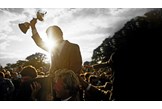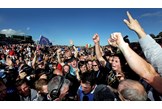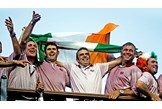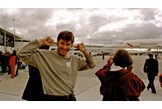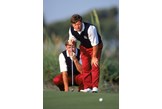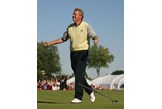18 ways to win the Ryder Cup
Published: Last updated:
From dictating the course set-up to motivational team talks to inspired pairings, eight former Ryder Cup captains reveal their secrets for Ryder Cup victory.
Our panel of experts
John Jacobs, Europe 1979/81: Lindrick born, Jacobs played in only one Ryder Cup, (1955) but was unbeaten.
Billy Casper, USA 1979: A member of the team eight times, Casper won 69 times as a professional.
Tony Jacklin, Eur 1983 – 1989: He won the Open Championship in 1969 at Lytham and the US Open in 1970.
Ray Floyd, USA 1989: A winner of the Masters in 1976 and the US Open 10 years later.
Bernard Gallacher, Eur 1991 – 1995: Played in the Ryder Cup 8 times; and in 1969, aged 20, was the youngest ever.
Lanny Wadkins, USA 1995: Played in eight Ryder Cups and won the 1977 PGA Championship.
Sam Torrance, Eur 2002: As well as winning 42 events as a pro, he played in the Ryder Cup eight times.
Bernhard Langer, Eur 2004: Winner of two Green Jackets (1985 and 1993) he has had 90 wins as a pro.
1. Make your wildcards count
Tony Jacklin: “I asked for an extra wildcard in 1983 for two reasons. First, the person in 10th place often qualified without winning an event and I wanted a team filled with winners. Secondly, many great matchplay golfers are not so good at strokeplay, which makes it difficult for them to qualify. Manual Pinero was a terrific match player, but only reasonably good at medal play. I wanted the extra pick so I could select someone like Manuel.”
Bernhard Langer: “Colin Montgomerie was a fairly obvious choice for my first wildcard. My second was far more difficult. A few weeks before I made the decision, I sent Anders Forsbrand to spy out Oakland Hills. I wanted to know whether I needed to pick a straight driver or a guy who missed a bunch of fairways but was a good putter and iron player. Anders said it was a tight driving course, so I chose Luke Donald, as I felt he was a little bit better driver than Freddie Jacobson, who was 11th on the points list.”
Ray Floyd: “The Ryder Cup is the toughest, most pressure-filled competition a golfer will ever play, especially when he is a rookie. Since a lot of rookies qualified for my team automatically, I knew I had to pick hardened veterans. I went for Tom Watson and Lanny Wadkins. I couldn’t have done anything else.”
John Jacobs: “We had two picks in 1981. I say ‘we’ because myself, Neil Coles and Bernhard Langer, who was leading the Order of Merit, chose the wildcards. Our first pick was Peter Oosterhuis, who had just won the Canadian Open. This left one space for Jacklin or James. We couldn’t make up our minds, so we said, ‘If one or the other was playing for your life, who would you rather have?’ We all said Mark James, because Tony Jacklin was past his best. Tony never forgave me.”
2. Create great team spirit
Billy Casper: “A good captain unites his 12 men as a team. In 1979, I put on dinner for my players and their wives. When I played in the Ryder Cup we’d been close, because everyone on tour stayed in the same hotels and our wives would watch each other’s children. Then more money came into the game. This is the biggest hurdle Captain Watson has to overcome at Gleneagles.”
Sam Torrance: “Team spirit is huge and it begins with the now traditional motivational video. This is one of the first things all the players ask for when they arrive, because it contains highlights from the best moments of each of their careers. Each montage lasts about three or four minutes. It’s great, it makes everyone feel special.”
Ray Floyd: “This is the key to captaincy. I think my proudest achievement was inviting the wives and caddies into the team room. I was the first captain to do this.”
John Jacobs: “I wrote to my players before the 1979 matches. I told them a happy team was likely to be a winning team and the only thing I asked of them was that they dressed smartly for the plane and turned up on time when I called a team meeting. When we got to the airport Ken Brown and Mark James were dressed like they were going fishing, which wasn’t a good start. The way those two behaved in 1979 made it so difficult for the team and myself. They became two of my greatest friends, but at the time they were heavily fined and banned for a bit.”
3. Learn from winning captains
Ray Floyd: “Paul Azinger was the most successful American Ryder Cup captain of recent times. He was very into the psychology of the players and getting them paired with someone who matched their personality, and I believe that’s why his team was successful. The way that Paul put the pods together was brilliant, everybody was always on the same page.”
Bernhard Langer: “When I became captain, I looked back on what I’d heard and seen during my playing days and realised that some captains had done certain things extremely well and others had done things I would have done differently. I tried to incorporate all of the positive stuff into my captaincy.”
Billy Casper: “Ben Hogan and Byron Nelson were the two best captains I played for, because they took time to evaluate and understand their players. This is crucial, because as a captain you really have to know your players.”
Bernard Gallacher: “I tried to incorporate the best bits of each captain I played under, but my main goal was to continue the good work Tony Jacklin had done. Tony had brought in things like the team room, which really boosted team spirit and I wanted to keep this spirit going.”
4. Consult experts
Sam Torrance: “I have known Sir Alex Ferguson off and on for a long time and since there is no greater manager of men, I asked for his help in the run up to the matches. The best thing he told me was that there are no stars in a team. Your best player is not any better than your worst player, because it is a team event.”
Bernhard Langer: “I talked to German football legend Franz Beckenbauer and he told me that communication was the key. If a player doesn’t understand why decisions have been made, then he is not happy and that is not good. I needed everyone to be happy and I needed them all to feel like they were doing whatever they were doing for the team. If they were playing, they were doing it for the team. And if they were sitting out, they were doing it for the team. The team was the important thing. In the Ryder Cup, it is not about how often someone plays or how many times someone wins or loses, it is all about the team.”
5. Make players feel special
Ray Floyd: “When I introduced my team, I plagiarised Ben Hogan and described them as ‘The 12 greatest players in the world’. I used it because I wanted to fire my guys up and show them how much I believed in them. I knew the European side would be fired up and I wanted my guys to care about the result just as much as they did. I was criticised for it afterwards, but that’s why I used the line.”
Sam Torrance: “The idea of giving the players gifts came from Tony Jacklin. He transformed the Ryder Cup for the players. Because of him, everything was first class – from cashmere jumpers to flying on Concorde. It made you feel special and I wanted to make sure that my players felt the same way. My wife and I made sure that there was a new gift waiting in the guys’ rooms each night.”
Tony Jacklin: “Once or twice Bernhard Langer said, ‘I need to rest.’ But I couldn’t afford to rest him because he was too good. I said, ‘Bernhard, you are a major champion. You will do better a little bit tired than most players will feeling 100%.’ I could see his chest fill. People like Bernhard want their captain to boost their confidence. They like to hear someone say they’re good. Bernhard went out and did a great job.”
6. Put pairings in right order
Bernhard Langer: “Pairing Tiger and Phil didn’t make any sense, but I had a feeling that Hal might do it and, if he did, he would put them out first. If this happened, I didn’t want two rookies to come up against them, so I put Monty and Harrington out first. I knew they had been there before and could handle the heat.”
Ray Floyd: “In the mid-to-late ’80s Europe had nine or 10 guys who played in every team. So, I knew who Tony was going to pair and what position he was going to send them out. I told my players to let me know who they wanted to play, because I knew where Tony was going to put them. They looked at me like I was crazy, but, sure enough, I managed to predict Tony’s exact line-up for the first morning. I knew what he’d do, because I had a record of what he had done. It had been successful, so why would he change?”
Tony Jacklin: “Everyone expected Seve and Ollie to go out first, but that wasn’t the way I saw it. For me, Seve and Ollie were a guaranteed point unless they played against America’s two best players and the Americans had a really good day. If that happened, then the US might get a half. Subsequently, I used to put Seve and Ollie out third or fourth as I didn’t want to risk a half point by exposing them at the top of the order where the US captain was likely to put out his best players.”
Sam Torrance: “I never watched the Americans hit a shot and I didn’t care what Curtis did or where he put his players. All I tried to do was put out my best four teams each session.”
John Jacobs: “At Walton Heath, America had such a strong team there was no point in worrying about who would play where. I just thought about my team and the fact that if I wanted them to play early in the afternoon, then I should put them out early in the morning or they wouldn’t have time for lunch. Dave Marr, who was the American captain in 1981 and a lovely chap, forgot this and it meant that Tom Watson and Jack Nicklaus had to go straight from the 18th to the 1st tee without stopping for lunch. I got sandwiches sent out to them!”
7. Get the right partnerships
Tony Jacklin: “In 1983, it was difficult to find a partner for Seve, because most of the team were in awe of him. I had a hunch that Paul Way could handle the pressure and it proved to be one of my greatest moves. Seve wasn’t happy at first. He said “This boy,” referring to Paul. “I tell him, ‘No, no, no, not that club, use this club’. I feel like his father.” I said, ‘Seve, you are his father in here’ and pointed to my head. Suddenly, the penny dropped. Seve’s back straightened, which was fascinating. They ended up bringing the best out of each other and being brilliant.”
Sam Torrance: “The pairings are great fun. I had a lot of ideas prior to the event, but everything goes up in the air when you see how people are playing. My best team of the week hadn’t played together before Friday. On Thursday night, it came to me that I was going to put Garcia with Westwood and they ended up getting three-and-a-half points from four matches.”
John Jacobs: “In the lead-up to the 1979 matches, I wrote to each player and asked them who they would like to play with. Most said, I could partner them with anybody, but there was the odd one who said, ‘I definitely don’t want to play with him’ or the reverse. Originally, Tony Jacklin wanted to play with Michael King, as they were buddies, but during the week he said he’d rather play with Sandy Lyle.”
Bernard Gallacher: “Seve was struggling in 1995, but I thought he should play before the singles, so I paired him with David Gilford, who was the straightest player I had. I had faith in David and knew that, with Seve in his ear, he could win the match on his own. He did just that.”
8. Settle the rookies
Billy Casper: “The rookies hold the key to the Ryder Cup and the 2012 matches proved this. The American rookies played great golf on Friday and Saturday, but the singles is a completely different atmosphere and when it changes the pressure gets so intense. The atmosphere switched overnight at Medinah and the American rookies couldn’t cope.”
Bernard Gallacher: “You ‘blood’ rookies by putting them with an experienced player. On my debut, Eric Brown paired me with Tony Jacklin in practice and it really helped me get the gist of the event. It also helps the captain. If new players can cope with playing with stars like Jacklin, Seve and Faldo in practice, then they can cope with the real thing.”
Sam Torrance: “Each rookie is different. There is not a blanket treatment. You have to see how a person is reacting before you can step in and suggest something. It’s not something you can pre-plan.”
9. Be the boss
Tony Jacklin: “You’ve got to treat the players respectfully, but some captains go too far. I think a recent American captain asked Tiger who he wanted to play with. I never asked Seve that. I told him who he was playing with. I made the decision, because I knew that you get a really muddy picture if you start asking the floor.”
Lanny Wadkins: “The Ryder Cup isn’t about what feels good; it’s about what is going to work. I was the captain, so I took charge of who played with who. I think you’ll see this when Watson captains again. He’s not going to say ‘play with your buddies’, because that doesn’t work.”
10. Know when to rest big guns
Tony Jacklin: “If I saw someone who looked like he wasn’t happy I would approach him. In 1985, Nick Faldo was going through a divorce and I didn’t think he was firing on all cylinders. I took him to one side and said that he didn’t look like he was playing his best. I asked him if he wanted another go, or if I should put Ken Brown in. I said, ‘As captain, I want you to be honest.’ He replied, ‘Put Ken in.’”
Bernhard Langer: “Monty was struggling in 2004. I watched him on the Saturday morning and felt that it would be detrimental to the team to send him out again in the afternoon. I told him I was giving him the afternoon off, so he could practice, rest and be ready for Sunday, which was the most important day. People need to be in form on Sunday, because there are 12 points on the line.”
11. Get the right singles order
Bernard Gallacher: “I’ve always felt your best player should go out first or sixth. If he goes out first, he can lead the team. If he goes out sixth, he is in a good position to turn things round and get the momentum going your way.”
Sam Torrance: “The idea of top loading the singles order had been suggested to me several years before, and the more I thought about it the more I liked the idea of putting my strength out first and then filtering it down to the last man. If you’re behind then you want a fast start, and if you’re ahead then you want to get further ahead. I would have looked foolish if it had gone wrong, but it didn’t.”
Tony Jacklin: “Historically, Ryder Cup captains had put their weakest player at the start and their strongest player at the end, but in 1983 I turned the list upside down, because I was behind and I didn’t see the point in having my strength at the end if we had already lost by then. When we opened the envelope and Jack saw that I’d put all my best players at the top, he said: ‘You can’t do that…’”
Billy Casper: “When the match is close, you want your top players to go out early, win their matches and make it easier for the rest. This was the big mistake Davis Love III made at Medinah. If he’d put some of his key players at the beginning then it would have been all over, but instead he placed some rookies near the top of the order and they folded as the pressure mounted on the back nine. This enabled the European team to start a trend that eventually won them the match.”
Bernard Gallacher: “In 1995, Seve was going to lose his singles match, so I put him off first to get rid of the point right away. The night before, he’d asked where I was playing him. I said ‘number one’. He replied, ‘I’m not playing well enough.’ I had to explain that the middle matches were going to be crucial and I wouldn’t be protecting him at the back as it might go right to the end. Seve knew that he was a sacrificial lamb, but he made the best of it and was all-square after nine, which inspired the team. They knew that if Seve could match one of America’s best they could win their matches.”
12. Manage the crowd
Bernhard Langer: “It’s much harder to play away from home in the Ryder Cup, because you’re not used to people cheering when you hit a bad shot. At most events people go ‘ooh’ or ‘ahh’, but at Ryder Cups in America they scream: ‘Yeah. Go USA.’ It is a different atmosphere, so when Paul McGinley suggested we try to win the crowd over by signing autographs and posing for pictures during the practice rounds, I thought it was a brilliant idea.”
Bernard Gallacher: “When we arrived at Kiawah, the Americans – who’d lost in ’85 and ’87 and tied ’89 – were desperate to get the Cup back. As a result, Dave Stockton tried to muster the help of the spectators, which was fine. There was nothing devious about his actions. The problem was the crowd just went too far.”
Lanny Wadkins: “I was not a fan of Bubba Watson whipping up the crowd at Medinah. I’m old school. When a player gets the crowd involved it takes away from the golf. The crowd should respond to the golf rather than the antics of the players.”
13. Set up to suit your team
Sam Torrance: “If you’re the home captain, you’ve got to make sure the course is set up to suit your team. In my year, the Americans were a bit longer than us, so I made sure that the fairways were narrower from 280-330 yards and the rough was up a little bit to negate their length. The greens were also a little bit slower than they are in America and there was no rough around the greens because the Americans were better at chipping out of long grass near the putting surface.”
Lanny Wadkins: “I had as much influence on the course set-up as I could. I looked at the make-up of my team and thought they would play a US PGA or US Open layout very well, better than the opposition. I did not have a long-hitting team, but I had a very straight-hitting team, so I worked with the PGA of America to determine length of the rough and the width of the fairways.”
14. Know when to split a pair
Tony Jacklin: “Faldo and Woosnam worked wonderfully at Muirfield Village, but the partnership wore out after that. People move on.”
Billy Casper: “I had Lee Trevino and Fuzzy Zoeller on my team. I paired them thinking they would talk their way to victory, but in actual fact they relaxed the other team so much they got beaten. I said, ‘That’s it, you’re not playing together ever again!’”
Bernhard Langer: “I didn’t think splitting Garcia and Westwood was a risk in 2004, even though they’d won three points together in ’02. I talked to the players and looked at their strengths and weaknesses. Most were complete players, but some did some things slightly better than others. Luke and Sergio were good friends and I felt they’d be a stronger foursomes combination than Sergio and Lee, so that’s what I went with.”
15. Everybody plays before sunday
Ray Floyd: “It is such an honour to make a Ryder Cup team, I decided early on that I was not going to captain a player who only played in the singles. I told my team: ‘Everybody is going to play. You deserve to be here, so you deserve to play. That means more to me than winning or losing’.”
Bernard Gallacher: “I always told my team members that they would all play before the singles, no matter how the matches were going. It was amazing how saying that at the start of the week kept them on their toes, both in the practice rounds and once it all started.”
Bernhard Langer: “Everyone should play at least one match, and preferably two, before the singles. On Sunday, there are 12 points available and nowhere to hide. You can afford to let a rookie experience the atmosphere during a fourball match, because, if he messes up a few shots, he has an experienced partner who can help dig the team out of a hole. In a singles match, he’s on his own.”
Billy Casper: “I didn’t play Gil Morgan but I should have because it took a long time for him to get over it. Some guys will only ever play in one Ryder Cup, and captains should take this into consideration. Everybody should play.”
16. Pass on valuable information
John Jacobs: “The biggest mistake I made was not telling Seve Ballesteros and Antonio Garrido to get focused right away after a rain delay in 1979 when they were 1-up. I knew the Americans would re-focus during the break and come out fast, but I failed to say this to Seve or Antonio. Sure enough, their opponents won two of the first four holes after the delay and went on to win the match.”
Bernhard Langer: “My vice-captains and I watched every shot at Oakland Hills. One day, we saw a few guys in the first group hit it into the creek on a par 4 with a blind tee shot. It turned out the fairway had dried out and the ball was rolling 20 yards further than the day before. I immediately went to that tee, so I could tell my guys about the change in conditions. I also gave advice on par 3s. I would watch the first group and then tell the remaining groups stuff like, ‘You don’t want to be long because you can’t stop it.’ I wasn’t trying to tell them what club or shot to hit. I was just trying to give them as much information as I could.”
17. Give good team talks
Bernhard Langer: “On the Saturday night, I said: ‘We’ve beaten them in foursomes and fourballs and tomorrow we’re going to beat them in singles.’ I wanted them to be confident, but not over- confident, so I added, ‘I want you to all go out there as if the match is even. The Americans usually win the singles, but we’re not going to let that happen this time. You guys have proven you’re better than them; now go out and do it again tomorrow.’”
Sam Torrance: “Team talks, what are team talks? You sit there, have a laugh and talk about the next day. There are no Winston Churchill speeches. It’s just about getting the boys’ heads right for the next day.”
Lanny Wadkins: “On the Saturday night in 1995, Corey Pavin chipped in on the 18th to give us a two-point lead going into the singles. After that my big job was trying to calm everybody down. I said, ‘Tomorrow, you’ve got to take care of your own business, because in the Ryder Cup you can’t wait for the rest of your team to do it for you.’ I tried to stress that everyone needed to treat their match as being life or death and for the Cup.”
Ray Floyd: “When the 1989 matches finished, several of my players were devastated, because they’d just needed to half a hole to win the Cup and couldn’t do it. I told each of them, ‘It’s not about you or the last hole or the last two holes. We have been preparing and playing for a week and we are a team, so we go down as a team or we win as a team. One individual doesn’t win or lose the Ryder Cup.’ This is something every captain and team needs to keep in perspective.”
18. Cross your fingers!
Lanny Wadkins: “The media always looks for reasons, but sometimes the other team just plays better. In 1995, we lost because half a dozen guys didn’t play to their potential on Sunday. That can happen. Everybody is human. Even Tiger and Rory don’t play their best every day.”
John Jacobs: “Why did we lose the 1979 Ryder Cup? Jacklin, Garrido and Barnes all lost on the last green on Sunday morning.”
Ray Floyd: “I was pleased with the singles draw in 1989, but we came unstuck on the 18th. I was on the tee with all of the guys who lost that hole. I patted them on the back, told them to get a good visual of the shot and then hit it. A couple hit it in the water and lost the hole, and then Fred Couples, who had driven it 300 yards down the middle, hit an 8-iron into the corporate tents to the right of the green. How can a captain predict that? It’s just the pressure of the moment and it proves no matter what the captain does, the players still have to play.”
Bernard Gallacher: “In 1993, Barry Lane was 2-up with five to play. Then Chip Beck finished something like birdie, birdie, eagle, birdie to win. You really can’t begin to legislate for that.”
Sam Torrance: “In the cauldron of the last four singles matches anyone can stand up and be counted; and, similarly, anyone can fold. The 2002 matches proved this. Phillip Price beat Phil Mickelson. Jesper Parnevik, whose game had been so off all year, halved with Tiger Woods. Paul McGinley halved with Jim Furyk. And Pierre Fulke halved with Davis Love III. These were fantastic performances right in the heat of the battle.”

